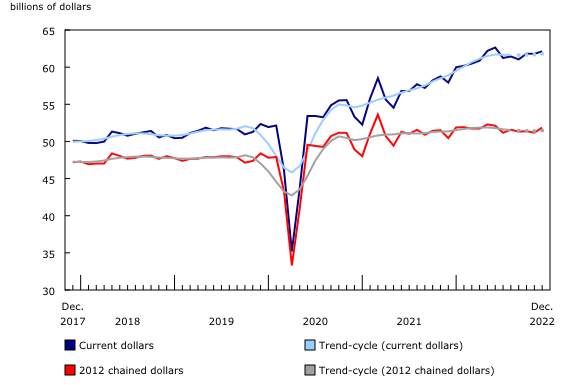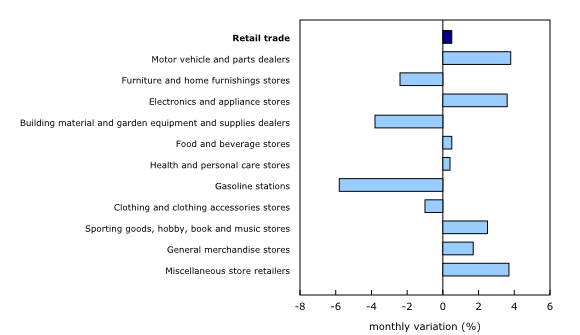Retail trade, December 2022
Released: 2023-02-21
$62.1 billion
December 2022
0.5% 
(monthly change)
$921.5 million
December 2022
0.7% 
(monthly change)
$278.8 million
December 2022
-0.5% 
(monthly change)
$1,685.4 million
December 2022
-1.0% 
(monthly change)
$1,360.4 million
December 2022
-0.9% 
(monthly change)
$14,132.2 million
December 2022
1.1% 
(monthly change)
$22,632.6 million
December 2022
0.9% 
(monthly change)
$2,198.6 million
December 2022
-0.6% 
(monthly change)
$2,107.4 million
December 2022
-0.2% 
(monthly change)
$8,183.0 million
December 2022
1.4% 
(monthly change)
$8,417.0 million
December 2022
-1.1% 
(monthly change)
$84.7 million
December 2022
-1.0% 
(monthly change)
$72.1 million
December 2022
1.0% 
(monthly change)
$48.9 million
December 2022
-1.1% 
(monthly change)
Retail sales increased 0.5% to $62.1 billion in December. Sales increased in 7 of 11 subsectors, representing 75.1% of retail trade. Higher sales at motor vehicle and parts dealers (+3.8%) and general merchandise stores (+1.7%) led the increase.
Core retail sales—which exclude gasoline stations and motor vehicle and parts dealers—increased 0.4%.
In volume terms, retail sales increased 1.3% in December.
Retail sales increased 8.2% in 2022, led by gasoline stations and general merchandise stores. In volume terms, sales were up 1.5% in 2022.
On March 24, 2023, Statistics Canada will release the official Monthly Retail Trade Survey estimates for the reference month January 2023. This release will include new retail estimates using the 2022 North American Industry Classification System (NAICS 2022). At this time, Statistics Canada is providing an advanced estimate of retail sales, which suggests that sales increased 0.7% in January. This unofficial figure will be revised as the program transitions to the new industry classification and more respondent data are received next month. Please consult the Note to readers at the bottom of this release for further information regarding NAICS 2022.
Higher sales at motor vehicle and parts dealers drive retail sales
Sales were up 3.8% at motor vehicle and parts dealers in December, a fifth consecutive monthly increase. The gain was led by higher sales at new car dealers (+5.0%), which posted its largest increase since February 2021. Higher sales at used car dealers (+2.1%) and automotive parts, accessories and tire stores (+1.0%) also contributed to the gain.
Lower sales at gasoline stations (-5.8%) posted the largest decline in retail trade in December. In volume terms, sales at gasoline stations increased 4.7%. Gasoline prices fell 13.1% on an unadjusted basis in December, the largest monthly decline since April 2020. Lower prices for crude oil were observed amidst concerns of a slowing global economy and reduced global demand following an increase of COVID-19 cases in China.
Core retail sales rebound
Following the decline in November, core retail sales were up 0.4% in December. Higher sales at general merchandise stores (+1.7%) led the increase in core retail. This marked the third increase in the last four months, as many consumers were seeking additional retail options to grocery stores for food and beverage purchases.
Higher sales at food and beverage stores (+0.5%) also contributed to the increase in core retail sales. Sales were up at supermarkets and other grocery (except Convenience) stores (+0.6%) and beer, wine and liquor stores (+1.3%). On a year-over-year basis, prices for food purchased from stores were up 11.0%.
Building material and garden equipment and supplies dealers (-3.8%) posted the largest decline to core retail sales. Sales declined for four consecutive months amidst higher interest rates and deteriorating housing market conditions.
Sales up in four provinces
Retail sales increased in four provinces in December, led by higher sales in Ontario (+0.9%). Sales were up 0.4% in the census metropolitan area (CMA) of Toronto.
Retail sales were also up in Quebec (+1.1%). Sales were up 1.7% in the CMA of Montréal.
The largest provincial decrease was observed in British Columbia (-1.1%) and was led by lower sales at gasoline stations. In the CMA of Vancouver, sales were down 0.9%.
Retail e-commerce sales in Canada
On a seasonally adjusted basis, retail e-commerce sales were down 5.7% in December.
On an unadjusted basis, retail e-commerce sales were down 2.4% year over year to $4.4 billion in December, accounting for 6.5% of total retail trade. The share of e-commerce sales out of total retail sales fell 0.6 percentage points compared with December 2021.
The article "Retail e-commerce and COVID-19: How online sales evolved as in-person shopping resumed," published today, uses a custom data series from the Monthly Retail Trade Program. This paper investigates how retail e-commerce and in-store retail sales evolved beyond the early stages of the pandemic.
Note to readers
On March 24, 2023, Statistics Canada will release its Monthly Retail Trade Survey for January 2023. This release will include new retail estimates using the updated version of the North American Industry Classification System (NAICS 2022). All retail data in Canada (beginning 2017) will be adjusted to the new classifications for ease of comparability over time.
The overarching theme of the update is the digital economy. Online-only retailers will be placed in the same industrial groupings as their non-digital counterparts. This means that some industries have been reclassified to reflect both physical and online-only retailers, creating a change in how some industry groups are measured (for example, online-only retailers joining store-based retailers) and a shift in some of the time series. In other cases, industries with the same definition will have different categorization numbers due to the overall changes to the classifications.
The new NAICS structure will mark the beginning of retail e-commerce data organized by industry. Statistics Canada will advise its key stakeholders and data users of this more detailed structure closer to its eventual release.
All data in this release are seasonally adjusted and expressed in current dollars, unless otherwise noted.
Seasonally adjusted data are data that have been modified to eliminate the effect of seasonal and calendar influences to allow for more meaningful comparisons of economic conditions from period to period. For more information on seasonal adjustment, see Seasonally adjusted data – Frequently asked questions.
The percentage change for the advance estimate of retail sales is calculated using seasonally adjusted data and is expressed in current dollars.
This early indicator is a special product being provided in the context of the COVID-19 pandemic to offer Canadians timely information on the retail sector. The data sources and methodology used are the same as those outlined on the Monthly Retail Trade Survey information page.
Trend-cycle estimates are included in selected charts as a complement to the seasonally adjusted series. These data represent a smoothed version of the seasonally adjusted time series and provide information on longer-term movements, including changes in direction underlying the series. For information on trend-cycle data, see Trend-cycle estimates – Frequently asked questions.
Both seasonally adjusted data and trend-cycle estimates are subject to revision as additional observations become available. These revisions could be extensive and could even lead to a reversal of movement, especially for the reference months near the end of the series or during periods of economic disruption.
Seasonally adjusted estimates for cannabis store retailers are presented in unadjusted form as no seasonal pattern has been established by official statistics yet. Establishing such a pattern requires several months of observed data. In the interim, the seasonally adjusted estimates for cannabis store retailers will be identical to the unadjusted figures.
Statistics Canada's retail e-commerce figures include the electronic sales of two distinct types of retailers. The first type does not have a storefront. These businesses are commonly referred to as pure-play Internet retailers and are classified under the NAICS code 45411—electronic shopping and mail-order houses. The second type has a storefront and is commonly referred to as a brick-and-mortar retailer. If the online operations of a brick-and-mortar retailer are separately managed, they, too, are classified under NAICS code 45411.
Some common e-commerce transactions, such as travel and accommodation bookings, ticket purchases and financial transactions, are not included in Canadian retail sales figures.
For more information on retail e-commerce in Canada, see "Retail E-Commerce in Canada."
Total retail sales expressed in volume terms are calculated by deflating current-dollar values using consumer price indexes.
Find more statistics on retail trade.
Real-time tables
Real-time tables 20-10-0054-01 and 20-10-0079-01 will be updated soon.
Next release
Data on retail trade for January 2023 will be released on March 24, 2023.
Contact information
For more information, or to enquire about the concepts, methods or data quality of this release, contact us (toll-free 1-800-263-1136; 514-283-8300; infostats@statcan.gc.ca) or Media Relations (statcan.mediahotline-ligneinfomedias.statcan@statcan.gc.ca).
- Date modified:


